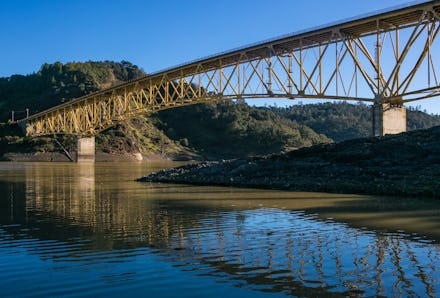California Is Letting Companies Pollute Its Water During the State's Worst Drought Ever

California is still struggling through what might be the state's worst sustained drought in 1,200 years. But in the dehydrated Central Valley, oil companies have been busy polluting much of the region's drinkable water.
Even worse, they've been doing it with the full cooperation of state regulators.
Because of a lack of proper government oversight, oil companies have been setting up waste disposal spots way too close to clean water reserves. Right now, state aquifers (underground layers of rock from which water can be extracted) remain intact. But according to recent projections, it may only be a matter of time until California is facing a dire situation and a potentially critical lack of drinking water.
The problem: As oil companies drill for their black gold, each Central Valley well typically produces 9-10 times as much waste-water as crude oil (not including the flood of chemical and acid byproducts generated by fracking). All of that waste has to go somewhere; more often than not, companies pump it right back into the ground at "injection wells."
If these injection wells are far enough from water supplies, there's no problem. But SFGate reports that when the Environmental Protection Agency transferred responsibility of the federal Safe Water Drinking Act to California regulators in 1983, the state allowed oil companies to establish disposal sites over formerly protected sources of clean or nearly clean water.
As a result, 171 waste injection wells now sit on aquifers that California's water agency considers pure enough to qualify for protected status. An additional 253 are located on "saltier but potentially usable aquifers" that the EPA would like to protect as well. Oil companies drilled 40 more wells into aquifers that hadn't been studied, for a total of 464 questionable wells.
The injection wells haven't been tied to any contamination of water supplies yet. But if energy companies keep polluting the potentially usable aquifers, they may become too contaminated to use in the future. Center for Biological Diversity Climate Law Institute director Kassie Siegel told SFGate that the problem is a "looming catastrophe" that threatens to ruin badly needed sources of water.
Meanwhile: Instead of slowing down, California's four-year drought is actually intensifying. The Wall Street Journal reports that January, normally the state's wettest month, set the state's second consecutive record low for rainfall. The city of San Francisco actually received zero measurable inches of rainfall during the entire month, and Department of Water Resources spokesman Doug Carlson told the paper that statewide snowpack (which would regularly melt and feed into streams) stands at just 25% of its average levels.
Total rainfall in 2015 stands at just 2% of normal levels for California. According to the U.S. Drought Monitor, about 40% of the state is now considered in "exceptional" drought:
The ongoing drought is seriously impacting agriculture, which consumes 77% of California's water supplies. Officials have been coaching residents on water conservation, but there's simply not enough water to go around. Reserves sit at half of their 2012 levels.
"We've gone from really, really, really bad to really, really bad," Department of Water Resources Director Mark Cowin told the Washington Times. "We must prepare for the worst."
In this environment, preserving potential sources of water is of tantamount importance. Unfortunately, oil companies and state regulators are slowly wasting resources they may seriously need in the future. Thanks to global climate change, California's historic drought may soon be matched with galling regularity by future ones that stress the state's water levels even more.